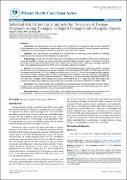| dc.description.abstract | Introduction: Teenage pregnancy and its effects on teen motherhood are among the major societal challenges
of the teenagers in the contemporary global community. In a 30 million population 25 percent pregnancy rate among
adolescents is an issue of great concern to the government and the whole of Uganda.
Objective: This study identifies and analyses the individual factors contributing to the prevalence of teenage
pregnancy among teenagers assessing Naguru teenage centre.
Methodology: A cross sectional study design was used employing both quantitative and qualitative approaches
using 384 population sample size among teenagers assessing Naguru teenage centre. A consecutive sampling
technique with structured questionnaire was used to identify the individual factors contributing to teenage pregnancy.
Data were statistically analysed using SPSS for the relationship between the variables.
Results: The result shows that 4 in every 10 teenagers accessing Naguru teenage centre were pregnant. Individual
risk factors found to be associated with teenage pregnancy were educational level (P=0.024, X2=7.452), age at the start
of contraceptives (P=0.049, X2=7.852), siblings are sexually active (X2=12.727, P=0.005) and siblings ever got pregnant
(X2=15.214, P<0.001). Teenagers that were not educated (OR=3.437, CI=6.906-1.711) were more likely to be pregnant.
Teenagers who start the use of contraceptives at the age of 13years and above were more likely to get pregnant (OR=2.484,
CI=4.938-1.25). Teenagers whose siblings were sexually active (OR=5.308, CI=11.295-2.494) were more likely to get
pregnant. Teenagers whose siblings ever got pregnant were more likely to get pregnant (OR=2.575, CI=4.642-1.428).
Conclusion: The study concluded that the prevalence of teenage pregnancy among teenager accessing Naguru
teenage centre is moderately high. Risk factors for teenage pregnancy were educational level, age at the start of
contraceptives, sibling sexually active and siblings ever got pregnant.
Recommendation: Government, Stakeholders, community leaders, teachers and parents have more efforts such
as sensitization, monitoring, counseling, etc to intensify on various means of reducing teenager’s pregnancy. | en_US |

